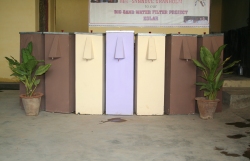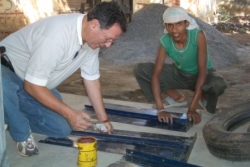|
Home | Blog| Sitemap | Privacy | Contact Us | ||

|
|
"Too Many Families, Not Enough Filters"In 2004, while returning to his 35-years-ago Peace Corps town in south India, accountant Mike Lipman of Hamden, Connecticut, was taken aback to see his old neighborhood’s backyard water wells were dry. The only available water was now delivered three times a week by the town tanker truck, and carried jug by jug into nearby houses. No piped water. No indoor plumbing. Just rudimentary backyard storage cisterns with water of questionable quality for drinking and cooking. On the spot Lipman decided to devote himself to find a sustainable solution for clean water. His research online and travels to Canada turned-up the ideal solution: Bio-Sand Filters. Made from poured cement into metal molds, this proven filter technology is in use in more than 40 countries around the world. Filters are made locally using local materials (cement, sand, gravel, copper tube, tin lid, water-based masonry paint) and instantly produce clean water as needed. “Bio-Sand Filters are cheap and effective,” says Lipman. “Filters use local materials, require no electricity, no moving parts, no chemicals, and deliver sustainable clean water for years with no maintenance. One household filter gives clean water to an entire household of 15 or more people for many years.” After Lipman and his wife, Cathy Forsberg, a financial consultant specializing in non-profits, formed a non-profit called the South Asia Pure Water Initiative, Inc. (SAPWII, pronounced “sap-wee”), and raised funds from their Hamden, Connecticut Rotary Club; they planned a 4-week trip to India in November 2005.
Within days of demonstrating the first finished filters to townspeople and nearby villagers requests for every producible filter committed every possible filter from the project’s single metal mold well into the foreseeable future. Lipman describes the initial experience: “We were amazed how fast word spread. The second day the workshop opened, a dozen householders were lined up to order a filter. Clearly even the villagers understood the crucial need for clean water in their house. It’s been a mad rush to keep up ever since.”
In order to meet the deluge of demand around Kolar District, SAPWII ordered several more molds for the Kolar Workshop within weeks as word of mouth spread the news. More molds were critical because one steel mold can only produce two filters a day. By the end of 2005 more than 100+ filters were produced. All spoken for. Early donations soon made it possible for the Kolar Workshop to add a cement mixer. Next came a delivery vehicle, a local version of a flat-bed pickup truck, to carry cured filters and filter sand/gravel for household installations. Once installed, a fully loaded filter weighs 230+ pounds including wet sand and gravel layers that produce clean water at one liter per minute as needed. What started out in late 2005 as a small-scale outdoor workshop in Kolar sifting and mixing materials by hand in split 50-gallon drums and delivering filters and their sand/gravel media by bullock cart, quickly grew into an international non-profit. By the end of its first year SAPWII manufactured 1000 filters and installed 750+ clean water Bio-Sand Filters to households in villages and towns in southern India. SAPWII’s vision calls for producing and installing 15,000 filters to serve an estimated 225,000 people around south India by 2011 and provide ongoing sanitation education. One out of two Bio-Sand Filters the initiative produces is subsidized by donors, while the other filters are sold at cost to any household wanting clean water. Says Lipman, “It’s quickly become a situation of too many families and not enough filters.”
|
|
| |
||||||


 On their first whirl-wind visit that year Lipman and Forsberg lined up cooperation from the Bangalore, India, Rotary Club, as well as the DAHN Foundation, a non-profit based in Tamil Nadu state, focused on training and disseminating village-level water technologies. Soon Lipman and Forsberg had rented a workshop space in Kolar (capital of Kolar District, Karnataka state, about 60 miles east of Bangalore), hired a program director and workshop manager, established a workshop and produced their first filters in the third week of their trip.
On their first whirl-wind visit that year Lipman and Forsberg lined up cooperation from the Bangalore, India, Rotary Club, as well as the DAHN Foundation, a non-profit based in Tamil Nadu state, focused on training and disseminating village-level water technologies. Soon Lipman and Forsberg had rented a workshop space in Kolar (capital of Kolar District, Karnataka state, about 60 miles east of Bangalore), hired a program director and workshop manager, established a workshop and produced their first filters in the third week of their trip.